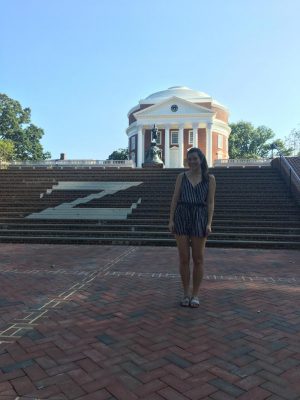My Summer in Charlottesville
The Rotunda at the University of Virginia, focal point of the grounds.
As a half Asian, half Caucasian person born and raised in the culturally diverse state of Hawaii, where my ethnic mix is common and accepted, racism was a distant reality. But upon leaving the unaware comfort of my home this summer for Charlottesville, Va., I realized that I am a minority, and was treated as such.
For two months, I conducted research among eight other undergraduate students in a diversity program at the University of Virginia, in the city of Charlottesville. There, I witnessed and experienced racism in a way that was unfamiliar to me growing up. Only 10 days after leaving the program, the palpable racial tension erupted into violence and unrest, positioning Charlottesville at the center of national news. The clash between white supremacists and counter protesters not only revealed the hatred that continues to plague American society, but instilled in me an unfamiliar fear after finally experiencing life as a minority.
My position as a person of color while living in the South was a shared experience. My peers in the Leadership Alliance Summer Research Early Identification Program were also categorized as minority students from institutions with limited funding for research, including Morehouse College, the University of Puerto Rico, and Vassar College, to name a few. This research program, which has roots in 30 universities across the country, was made specifically for students like us.

Gabriela Trinidad-Perez
For the majority of my program peers, who are from areas of the U.S. where discrimination is overtly sinister, racial oppression is the norm. Discussions about race were therefore commonplace in our group and in the beginning, left me feeling uncomfortable. I could not, no matter what capacity to empathize I possessed, identify with their struggles.
But it soon became blatantly clear, in a cultural climate much different from Hawaii, that people who looked like me were uncommon in Charlottesville. And while my experiences were nowhere near as harsh or traumatic as that of my program counterparts, I began to feel the pangs of subliminal racism that our sizable assembly of diverse students warranted in the whitewashed town.
While sharing a meal in a nice Italian restaurant downtown, two white elderly customers sitting nearby had their eyes fixed on our table of colorful individuals throughout their entire meal. Expressed through their intense glares was confusion – as it was obvious that our appearance was different from the patrons at surrounding tables – and discomfort. The tense furrowing of their brows communicated that we were a potential threat they should be wary of, but in turn, made me feel exposed and self-conscious.
Another vivid memory involved a close encounter at a crosswalk between my group of friends and a speeding car. While attempting to cross the street in a pedestrian right-of-way crosswalk, a driver seemed to purposely increase speed as he saw us step into the street. The incident appeared to be less than coincidental when the car, filled with young white males, slowed while passing us (three Latinas, one Asian, and one African-American) to serve us threatening looks. In that instance, my safety had been violated, seemingly contingent upon the color of my skin.
These personal experiences were only legitimized by the greater danger of institutional racism brewing in the southern town. One month into the summer, on July 8, members of the Ku Klux Klan gathered in protest of the removal of the Robert E. Lee statue that stands in Emancipation Park, only a five-minute bus ride away from campus.
Huddled around my roommate’s laptop in our kitchen that Saturday we watched a YouTube video of the protest. A mixture of unidentifiable figures in Klan hoods and belligerent, unmasked members stood in opposition to the citizens of Charlottesville that were outraged at this archaic display of racism. Standing between them were Charlottesville police dressed in riot gear. In those moments, it became clear that the racial tension we experienced was in no way imagined. Being forced to remain in the confines of my home to ensure my safety gave me a minor glimpse into the range of fear people experience to just exist, an emotion I had to address within myself for the first time.
The program at the University of Virginia ended on Aug. 1. Ten days later, Charlottesville made national headlines. On Friday, Aug. 11, a group of tiki torch-wielding white supremacists congregated on campus at the statue of founder and slave owner, Thomas Jefferson, situated in front of the Rotunda, the focal point of the grounds. Sparking outrage, white supremacists and white nationalists were confronted by counter protesters the next day at Emancipation Park. By the end of the weekend, three people had died and an estimated 34 were wounded.
Scrolling through news sites in the comfort of my Oahu home, I could recognize every area of town where these incidents were taking place. Mixed with the overwhelming sadness and fear that the news elicited was the feeling of profound gratitude that my friends and I were no longer there, the horrific what ifs playing on a constant loop in my mind. The potential that any one of us could have been hurt in the midst of the conflict, had we left a week later, hit home.
After spending the summer being regarded as an “other” for the first time in my life, I was finally able to come to terms with the way I perpetuate institutional racism, or at least fail to oppose it, by living in my comfort zone of ignorant bliss. No longer were the counter protesters merely distant Americans being run down by crazed drivers and hurled bitter slurs. The faceless people standing trial day in and day out to defend their humanity were finally given names because I realized that one of them could be mine.
